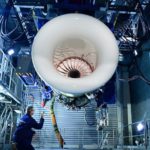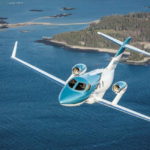Dassault Aviation’s new Falcon 8X will soon receive ‘operational credit’, allowing bad weather approaches to 100-foot minimum decision heights on aircraft equipped with Dassault’s FalconEye combined vision system.
The new capability recently completed a joint FAA/EASA certification campaign and will be introduced onto the market before the end of the year, Dassault says. It will permit pilots to make a precision approach at airfields without ground-based navigation aids down to a decision height of 100 feet, greatly expanding the number of airports the aircraft can serve in bad weather conditions.
Dassault describes FalconEye as: “The first head-up display to blend synthetic, database-driven terrain mapping and actual thermal and low-light camera images into a single view.”
Developed in partnership with Elbit Systems, FalconEye is equipped with a fourth-generation multi sensor camera that generates very high definition images. In synthetic vision system (SVS) mode, the camera displays a level of vision quality “comparable to that of the most sophisticated fighter HUDs”. Its 30 x 40 degree field of view ensures full coverage of the viewing area with no tunnel vision effects.
FalconEye has been available since early 2017, providing “an unprecedented level” of situational awareness to flight crews, Dassault says. The company reports that the vast majority of Falcon 8X operators have opted to install a FalconEye HUD.
Safety benefits
“With FalconEye we’ve not only developed an industry leading technology but provided a huge safety benefit to our operators,” said Eric Trappier, Chairman and CEO of Dassault Aviation. “With this coming certification, our customers will have even greater flexibility and access while at the same time benefiting from the enhanced situational awareness of the world’s most advanced combined vision system.”
In 2020, the FalconEye combined vision system is expected to become certified for use in a dual head-up display format, which in addition to further improving crew situational awareness and coordination will provide ‘CVS to land’ capability, allowing pilots to use the combined vision image instead of natural vision until touchdown when performing a precision approach.

